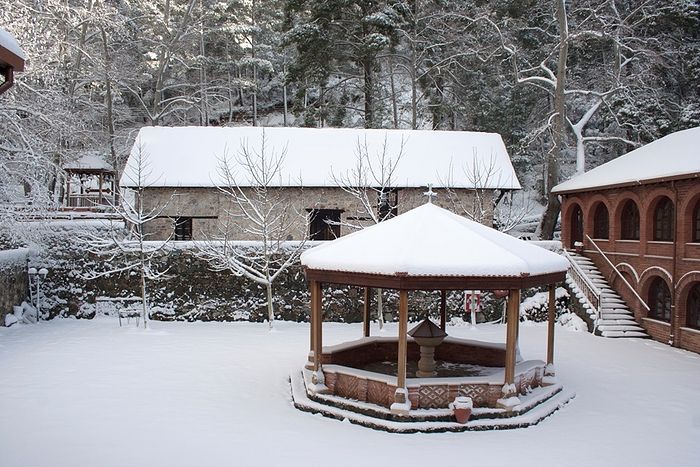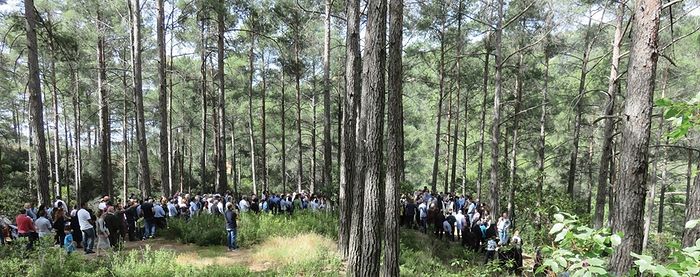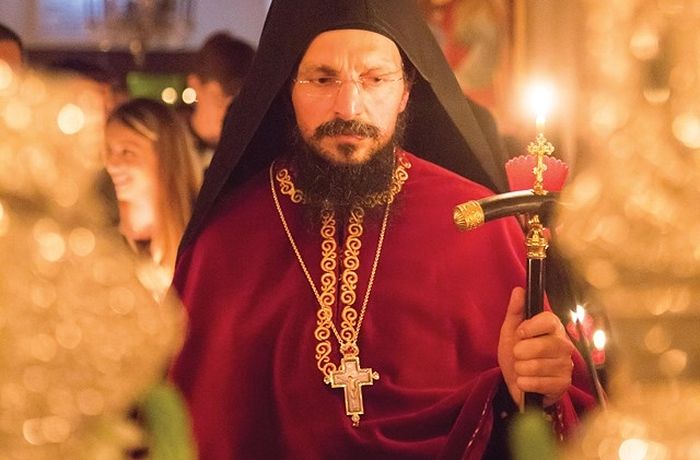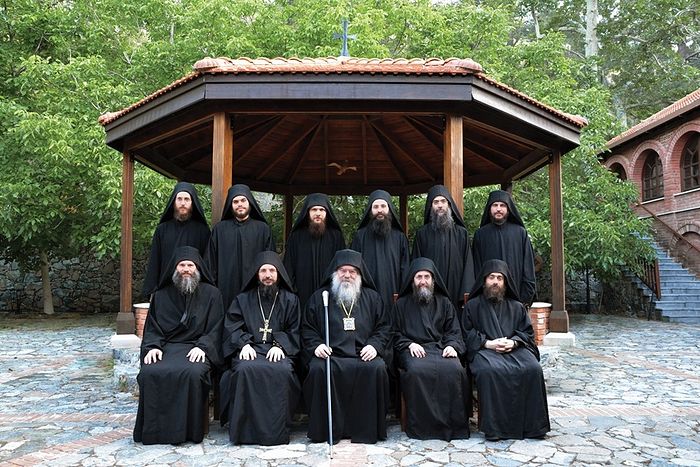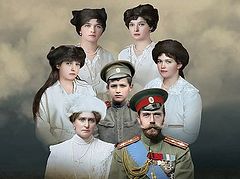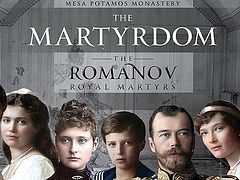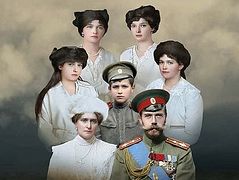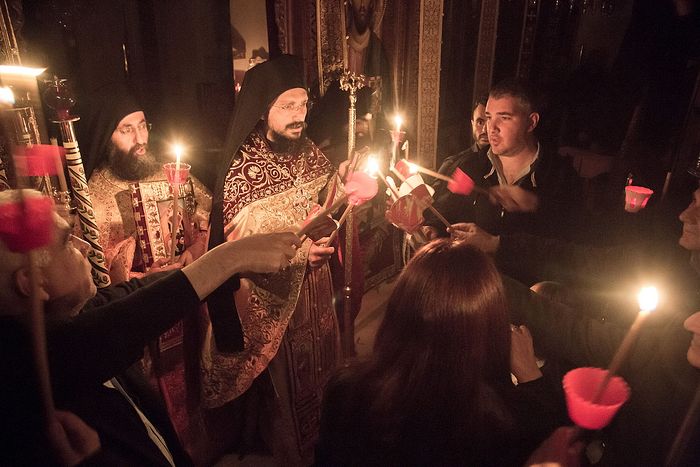 Holy Pascha at the Monastery of St. John the Forerunner in Mesa Potamos, Cyprus
Holy Pascha at the Monastery of St. John the Forerunner in Mesa Potamos, Cyprus
The Monastery of St. John the Forerunner in Mesa Potamos, Cyprus made contact with OrthoChristian in 2017 when they were preparing their Greek-language biography of the Russian Royal Martyrs. We published a news article concerning the publication, and several later articles about the English translation of the book, The Romanov Holy Royal Martyrs: What Silence Could Not Conceal.
This summer, I had the opportunity to make a short visit to the monastery in the mountains of Cyprus. The setting, in a forest in the mountains, pleasantly reminded me of St. Herman’s Monastery in Platina, California, as did the prayerful atmosphere. I was warmly welcomed by the abbot, Archimandrite Paisios, was given a tour of the monastery, and had the opportunity to meet several of the brothers, enjoy the monastery’s wonderful cooking, and venerate its holy relics and icons.
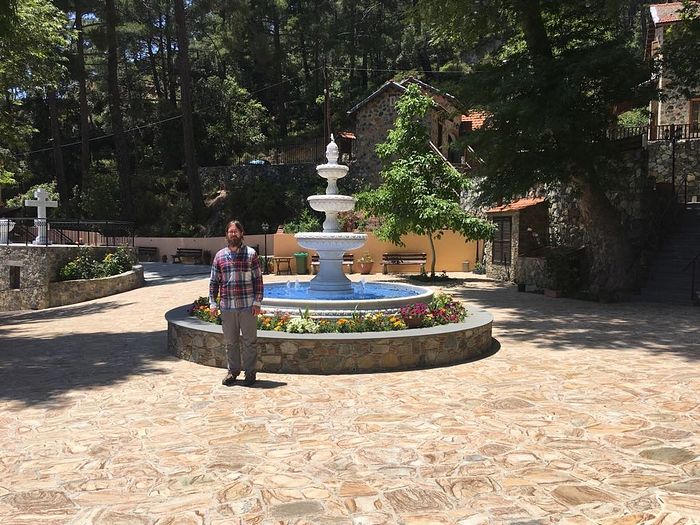 My visit to the Monastery of St. John the Forerunner
My visit to the Monastery of St. John the Forerunner
We therefore wanted to provide our readers with this interview with the brotherhood, in which we discuss the monastery’s history, its spiritual inheritance, its love of the Russian Royal Family and the American saints, and much more.
—Please tell us about the history of your monastery. How was it founded?
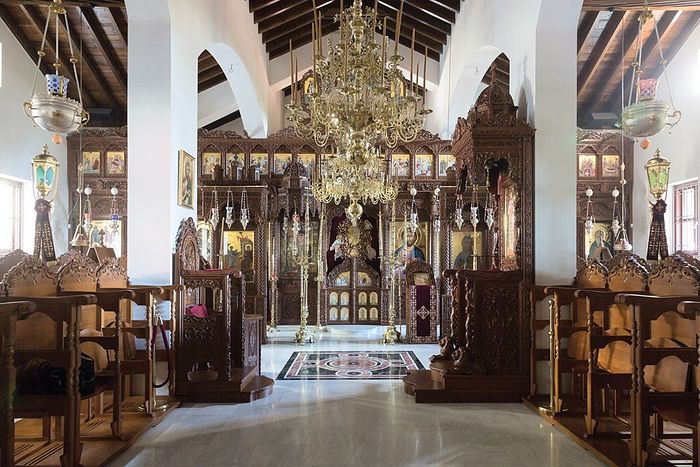 The new catholicon at the Monastery of St. John the Forerunner
The new catholicon at the Monastery of St. John the Forerunner
—Our monastery is dedicated to St. John the Forerunner (“Timios Prodromos” in Greek) and it is known as Mesa Potamos Monastery, named for the area in which it is located. It is situated between the villages of Platres, Saittas, and Kato Amiantos, and is found on the southern slopes of the Troodos Mountain. Information on its establishment and founders is, unfortunately, not known, but it is considered to be of the same age as the other major monasteries of Cyprus, namely Kykkos, Machairas, Trooditissa, St. Nicholas of Stegi, and others, which date back to the Byzantine period, and more precisely to the twelfth century.
The first written historic testimony about the monastery comes from a document of the Frankish king of Cyprus James II, who in 1468 granted the abbot, Fr. Gregory, and his nephew a quantity of wine and five “Byzantine dinars” from the kazan (provincial department) of the village of Kilani every year for the rest of their lives.
After 1821, we learn that many monks fled to the monastery, possibly to save themselves from the Turkish massacres and persecutions that followed during the Greek War of Independence. During that time, a rudimentary school for the region’s children was also founded at the monastery. However, in the end, our monastery was also abandoned like many others at that time. At the beginning of the twentieth century, there were attempts to revive the monastery by monks from the Monastery of Stavrovouni. However, this effort ultimately failed and the monks returned to their monastery.
In 1914, the Bishop of Kition, Meletios Metaxakis (who was subsequently elected as Archbishop of Athens and All Greece, Ecumenical Patriarch, and Patriarch of Alexandria), turned the monastery into a hotel! The hotel operated for many years, until 1950, when the place was again abandoned, and by 1998, the church and the monastery buildings were heavily damaged. In the meantime, in 1973, the monastery became subject to the re-established Bishopric of Limassol. Finally, the monastery was restored in 2003 under the guidance of Metropolitan Athanasios of Limassol, and in the same year, the monastery was populated by five monks from Machairas Monastery. The Monastery of St. John the Forerunner of Mesa Potamos was at the time the first men’s monastery belonging to the administrative region of the Metropolis of Limassol.
—Are there any saints connected with the history of the monastery?
—Due to the Latin occupation in Cyprus (eleventh to sixteenth centuries), the Local Orthodox Church was not allowed to have more than six bishops and these were forced to live in the countryside, not being allowed to reside in the place of their canonical Sees in the towns. Likewise, the Orthodox Church of Cyprus was not permitted to have a primatial archbishop, since the Latin archbishop in Cyprus was considered to be the ecclesiastical primate of the island. Nevertheless, the Orthodox faithful of Cyprus did elect their archbishop, who was, however, forced to carry the title of Bishop of Solia and reside in the village of the same name.
That person, in the mid-sixteenth century, was St. Theophanes, who prior to being elected was a monk in a monastery in Nicosia. St. Theophanes ended his life in the Monastery of Mesa Potamos in humble asceticism. One day, while still an acting hierarch, the saint confronted his economos [steward] about a mistake he had made, and the economos, who was a brash man, slapped the bishop on his face. The bishop, humble as he was, felt that he was no longer worthy of being in charge of the administration of the diocese. He therefore asked permission from the Latin authorities to resign from his post and he lived a secluded and ascetic life as a simple monk in our monastery.
During his life and after his death, the saint has performed a number of miracles. Around six years after his death, during the opening of his tomb, his relics were found to be incorrupt and streaming myrrh; therefore, he received the name of St. Theophanes the Myrrh-Streamer.
Just a few years after his repose, in 1571, the Turks occupied Cyprus and no information survives as to what became of the relics of the saint. To this day, no fragments of his relics survive.
—Could you describe the daily life at the monastery, including the liturgical life and obediences?
—Our monastery’s typicon is like those of the Athonite monasteries. Every day we start services at 4:00 AM, with the Midnight Office, Matins, and Divine Liturgy. This is never altered unless we have an All-Night Vigil. After the services, which finish around 7:30 AM, the fathers have a small breakfast and around 8:00 AM they start with their obediences, which continue until 12:30 PM. At 12:30 we have the Paraklesis (Supplicatory Canon) to either St. John the Forerunner or the Theotokos. At 1:00 PM we have lunch and the fathers dine together in the refectory, while one of them reads from spiritual books. There is a rest time from 2:00 to 4:00 PM, and from 4:30 to 5:45 PM we have Vespers, after which the fathers take a light treat (e.g. some fruit) in the refectory. At 6:30 PM we finish our liturgical cycle of the day with Compline and around 7:15 PM the monks withdraw to their cells for their monastic rule. Rest time is at 10:30 PM.
Our monastery’s main workshop is the bakery and confectionery. The fathers bake breads, including olive breads, and cheese pies, and they produce a wide variety of sweets and cookies, which are made available to visitors at the monastery’s bookstore. In addition to this obedience, we also produce apple vinegar, we grow various herbs for tea and cooking, we have an icon-painting workshop, and we publish spiritual books. All these products are also available at the bookstore. All other work at the monastery, of course, is also performed by the fathers, such as the cleaning, cooking, receiving guests, etc.
—How many monks currently live and labor there? Are they all from Cyprus?
—The brotherhood currently numbers thirteen monks, all from Cyprus.
—Your monastery has a great love and devotion for the Russian Royal Martyrs—Tsar Nicholas II and his family—which isn’t something you would typically expect from a Cypriot monastery. How did the connection between the Royal Martyrs and your monastery begin?
 An icon of the Royal Martyrs commissioned by the monastery
An icon of the Royal Martyrs commissioned by the monastery
—It all began when the abbots and abbesses of the monasteries of our broader monastic brotherhood were invited by the abbess of the Novo-Tikhvin Monastery in Ekaterinburg to visit. This invitation was addressed to us following a visit of our Elder, Metropolitan Athanasios of Limassol, to Ekaterinburg for a conference. While in Ekaterinburg, our abbot, Archimandrite Paisios, together with the rest members of the group, visited the holy places connected to the Royal Martyrs; that is, the Church on the Blood (on the site of the former Ipatiev House), the monastery named in their honor at Ganina Yama, and the final burying sites of the Royal Martyrs in the forest.
When our abbot returned, he told us it’s a pity that not even one book exists in the Greek language about the life and martyrdom of this saintly family. His experience from his visit to the places where they were martyred and buried was very strong. Therefore, since our monastery has always published books, our abbot deemed it just to publish a book about the Royal Martyrs, and this is how it came about.
Following the release of the Greek version of our book, we received a number of requests to publish an English version, and, by God’s grace, that has also been completed. The English version is now available, while a Romanian version of the book is being prepared by Diaconești Monastery.
—Your monastery also has a great love and veneration for the saints and elders of the twentieth century. Of course, all faithful Orthodox Christians revere them, but how did your monastery come to have a particular veneration for them, including elders not yet officially canonized?
—This was due to a special love and interest for these saints by our Elder Met. Athanasios. In 2015, he asked us to research the lives of the saints who lived in the twentieth century with the aim of publishing a service for the Synaxis of the Saints Who Shown Forth in the Twentieth Century. By God’s grace, this service is already published and many churches in Greece and Cyprus are celebrating this feast, appointed for the third Saturday of October.
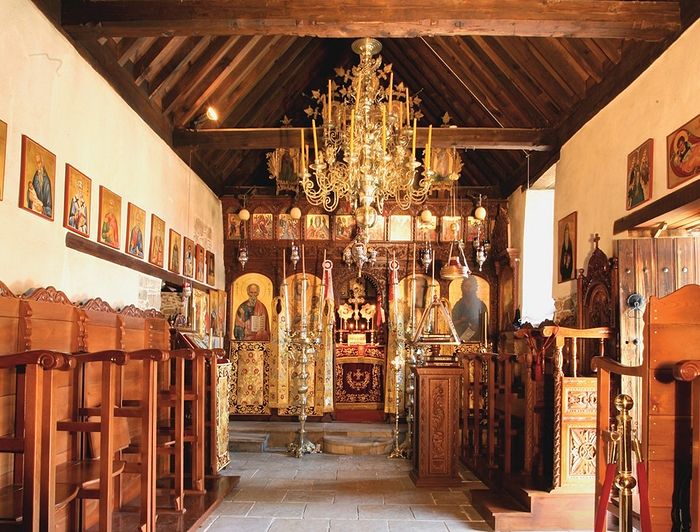 The old catholicon at St. John the Forerunner Monastery
The old catholicon at St. John the Forerunner Monastery
—Do you know if there are any plans to translate the service for the Synaxis into any other languages?
—No, we have not heard of any such plans. The truth is that it is not known in the English-speaking world that we have composed and published this service. Nevertheless, if any interest is shown, we would be happy to consider this option. Of course, as you can understand, it was impossible to include all the names of the saints from the twentieth century in a single service, but we have tried to include the most prominent ones from every country, and many more, in the canon (here is the link to the book).
But our elder has repeatedly mentioned in his homilies how the twentieth century was so rich in every aspect, that is, in the fields of art, science, technology etc., while at the same time it brought about some of the most tragic events in world history. He has also always been very impressed by the fact that the twentieth century gave the Orthodox Church the greatest numbers of saints of all times. Never before did the Church have so many saints, mainly martyrs of course, in such a short period of time. Also, the fact that these saints lived so close to us, under almost exactly the same conditions and circumstances as us today, gives us all the hope, courage, and strength to believe that sanctity is achievable even by us, who struggle at the end of times.
Therefore, our monastery is now preparing a short series of books with selected lives of these saints, which can inspire the Orthodox faithful in their own spiritual struggle. Our first volume, expected to be published in the summer of 2020, includes the lives of saints who lived in the Americas during the twentieth century. It is our wish to publish the lives of saints who are not so well-known among the Orthodox in Greece and Cyprus.
—It would be a great joy if our humble American Orthodoxy could offer something to the people of Greece and Cyprus. How was it decided to begin with American saints?
—The main reason is because we have a friend in America, Matthew Namee, who has devoted many years of his life to studying Orthodoxy in the Americas and has collected an abundance of materials on the subject. He was very kind to share this material with us and so it was very natural to start working with it. Matthew will be authoring an historical report on Orthodoxy in the Americas for our book, which will be included as an introductory chapter. This will help the readers understand the historical background in which the saints whose lives will be included in the volume lived and struggled.
Another reason for deciding to begin with the saints who shown forth in the Americas is because to this day such a book does not exist in the Greek language, and many people don’t even realize that there are actually saints who lived and glorified God with their deeds in that continent. Some of them are widely known and revered, like St. Tikhon, Patriarch of Moscow, but his work in the Americas has never been presented to Greek-speaking Orthodoxy. The rest of the saints are almost completely unknown, such as St. Sebastian of Jackson, St. Raphael of Brooklyn, and so on.
—Are there any among the twentieth-century elders that are most beloved at your monastery, or that you have a more direct connection to?
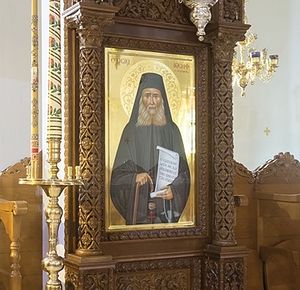 The monastery's icon of St. Joseph the Hesychast in the new catholicon —It is well-known that our Elder Met. Athanasios, is a spiritual descendant of the newly canonized St. Joseph the Hesychast. He started his monastic life on Mt. Athos in 1976 as a disciple of Elder Joseph of Vatopedi, who was a disciple of St. Joseph.
The monastery's icon of St. Joseph the Hesychast in the new catholicon —It is well-known that our Elder Met. Athanasios, is a spiritual descendant of the newly canonized St. Joseph the Hesychast. He started his monastic life on Mt. Athos in 1976 as a disciple of Elder Joseph of Vatopedi, who was a disciple of St. Joseph.
In 1992, our elder was invited by the late Archbishop of Cyprus Chrysostomos I to return to Cyprus and help establish a monastery here. His elder, Joseph of Vatopedi, accepted the invitation for his disciple, and even though our elder did not want to leave Mt. Athos, he was of course obliged to be obedient to his elder. Subsequently, in 1993, he was enthroned as Abbot of Machairas Monastery, and by 1998, when he was elected as bishop for the See of Limassol, the brotherhood of Machairas numbered thirty fathers. When he was again obliged to leave his monastery, he did not cease to be the elder of the fathers there, and to this day he visits the monastery every week, as well all the other monasteries that were populated by fathers coming from Machairas.
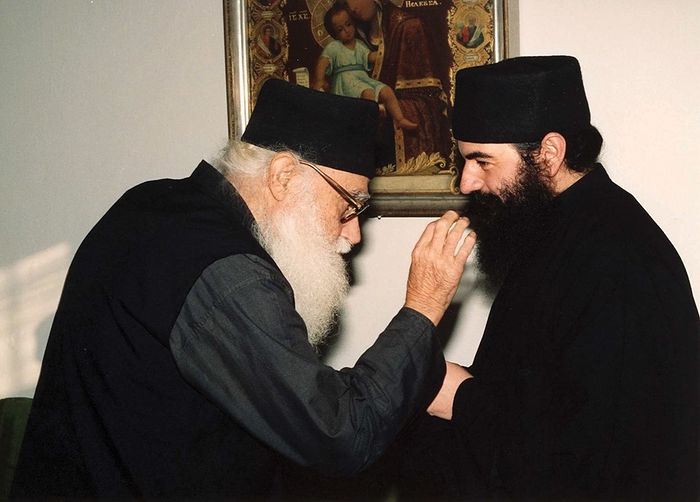 Met. Athansios (right) with St. Ephraim of Katounakia (left)
Met. Athansios (right) with St. Ephraim of Katounakia (left)
It is, therefore, obvious that our monastery holds St. Joseph the Hesychast at the peak of reverence, since he is the root of our monastic brethren and the head of our spiritual ancestors. His recent canonization filled us all with joy, as we have been expecting it for years on end. We also have a special reverence for St. Paisios and the also newly-canonized, St. Ephraim of Katounakia, with whom our elder was very closely and personally connected. It is enough for anyone just to listen to a few of our elder’s homilies to realize that he always refers to them and relates incidents from his experience from living so close to them.
—Our readers should be familiar with Met. Athanasios of Limassol, as we have translated several articles by him. What is life like with, or under, His Eminence? What does he offer to the life of the monastery?
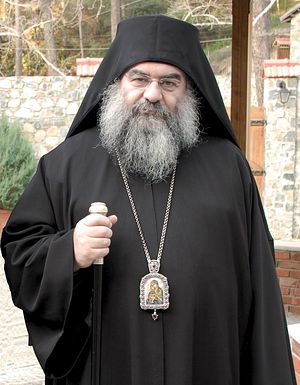 Met. Athanasios visiting the monastery —This is really a hard question to answer. The blessing we have is beyond human comprehension and any description. We know that we are the bearers of a great spiritual responsibility before God for being so blessed to be under the guidance of a person who has lived so close to so many saints and holy elders of our times. Our elder has gathered an immeasurable spiritual wealth from these great saints and he has made it his sacred purpose to impart this monastic experience not only to the monks and nuns under his spiritual guidance, but also to the lay people whose shepherd he has become.
Met. Athanasios visiting the monastery —This is really a hard question to answer. The blessing we have is beyond human comprehension and any description. We know that we are the bearers of a great spiritual responsibility before God for being so blessed to be under the guidance of a person who has lived so close to so many saints and holy elders of our times. Our elder has gathered an immeasurable spiritual wealth from these great saints and he has made it his sacred purpose to impart this monastic experience not only to the monks and nuns under his spiritual guidance, but also to the lay people whose shepherd he has become.
Nevertheless, it is very important for us to say that our elder is a very simple man. When he is around, we all feel like he is like our own father. It is very comfortable and easy to talk with him, since he is a very pleasant and agreeable person. This is probably precisely what makes him so special, because he is very approachable and therefore one can easily absorb all he has to share. In his everyday life he is like any ordinary person, but—and this is the mystery of spiritual people—regardless of this, one never loses the feeling that he is not at all a simple ordinary person, but rather a true man of God.
—Could you say a bit about your abbot, Fr. Paisios?
—Our abbot, Archimandrite Paisios, was born in 1972. He was blessed to meet and talk with St. Paisios a few times on Mt. Athos. During his first visit to Mt. Athos he met our elder, Met. Athanasios, who was at the time still an Athonite monk, a hieromonk. When our elder was called to Cyprus and initially resided at a monastery in Paphos for one year, our abbot, still a layman, would visit him there, and he expressed to him his desire to become his disciple. At the time, our elder’s monastic community consisted of only five fathers. One of them was the late Archimandrite Arsenios, abbot of Machairas Monastery, who was killed in a plane crash in 2004 while visiting Mt. Athos with Patriarch Peter of Alexandria. Another was Bishop Nicholas of Amathus (auxiliary bishop of the Metropolis of Limassol), who was the first abbot of our monastery, from 2003 to 2007.
Our abbot was preparing to join the community in Paphos when our elder and his disciple were invited to populate Machairas Monastery, and was enthroned as the abbot there in November 1993. Two months later, in 1994, our abbot joined the brotherhood of Machairas. He was the first to join the community there. In 2003, our abbot was among the five fathers who were chosen by our elder to populate our monastery here in Mesa Potamos. He was by then a hieromonk. In 2007, when our first abbot was elected as Bishop of Amathus, the brotherhood elected Fr. Paisios as its new abbot.
—Please tell us about the monastery’s relics and unique icons.
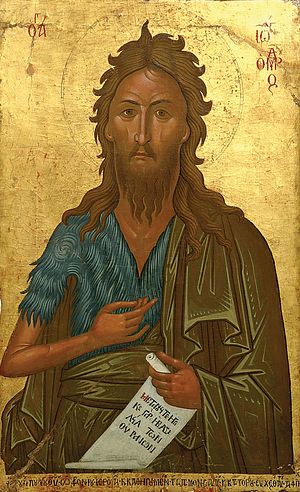 St. John the Forerunner —The main icon of our monastery is one of St. John the Forerunner which, according to the inscription on the icon, was painted in 1584. This icon was stolen in the 1970s from the iconostasis of the old catholicon (main church) of the monastery and was lost for almost thirty years. In 1998, it was located and identified by a Cypriot Byzantinologist at Diözesanmuseum in Freising, Germany. That was the year when our elder became the Metropolitan of Limassol and right from the beginning felt the desire to re-establish our monastery. What is even more surprising is that the icon was returned to the Metropolis of Limassol on the very day when our elder visited the monastery with the late Constantinos Leventis, who on that visit expressed the wish to cover all the expenses for the immediate renovation of the monastery. As soon as our elder returned to Limassol from Mesa Potamos, he found the icon “waiting” for him. The icon is now placed in the new catholicon of the monastery.
St. John the Forerunner —The main icon of our monastery is one of St. John the Forerunner which, according to the inscription on the icon, was painted in 1584. This icon was stolen in the 1970s from the iconostasis of the old catholicon (main church) of the monastery and was lost for almost thirty years. In 1998, it was located and identified by a Cypriot Byzantinologist at Diözesanmuseum in Freising, Germany. That was the year when our elder became the Metropolitan of Limassol and right from the beginning felt the desire to re-establish our monastery. What is even more surprising is that the icon was returned to the Metropolis of Limassol on the very day when our elder visited the monastery with the late Constantinos Leventis, who on that visit expressed the wish to cover all the expenses for the immediate renovation of the monastery. As soon as our elder returned to Limassol from Mesa Potamos, he found the icon “waiting” for him. The icon is now placed in the new catholicon of the monastery.
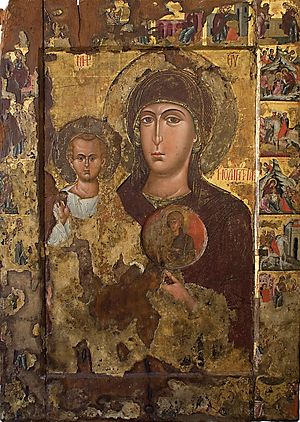 Panagia Saitiotissa Another ancient icon of our monastery is a “composite” one, which means that a small icon is inserted into a larger one. This is not a very frequent phenomenon; only a few composite icons survive to this day. Inserting a smaller icon into a larger one was intended to emphasize its value and it indicates that the inlaid icon was a greatly venerated one. The composite icon found in our monastery is of the Theotokos, known as Panagia Saittiotissa, deriving its name from the nearby village of Saittas, where the icon was kept in the chapel of a metochion (dependency) of the monastery in older times. The chapel and the metochion were destroyed at an unknown date and the icon was moved to the monastery. The larger icon was painted in the fifteenth century and it is surrounded by a frame with scenes illustrating the Akathist. Most of them are in very poor condition. In the center of the icon there is a smaller inserted round icon of the Theotokos, from the twelfth century. The icon of Panagia Saittiotissa is also in the new catholicon of the monastery, which is consecrated in honor of the feast of the Akathist precisely because of this icon.
Panagia Saitiotissa Another ancient icon of our monastery is a “composite” one, which means that a small icon is inserted into a larger one. This is not a very frequent phenomenon; only a few composite icons survive to this day. Inserting a smaller icon into a larger one was intended to emphasize its value and it indicates that the inlaid icon was a greatly venerated one. The composite icon found in our monastery is of the Theotokos, known as Panagia Saittiotissa, deriving its name from the nearby village of Saittas, where the icon was kept in the chapel of a metochion (dependency) of the monastery in older times. The chapel and the metochion were destroyed at an unknown date and the icon was moved to the monastery. The larger icon was painted in the fifteenth century and it is surrounded by a frame with scenes illustrating the Akathist. Most of them are in very poor condition. In the center of the icon there is a smaller inserted round icon of the Theotokos, from the twelfth century. The icon of Panagia Saittiotissa is also in the new catholicon of the monastery, which is consecrated in honor of the feast of the Akathist precisely because of this icon.
We are also blessed to have various relics, among which the most important is a fragment of the finger of St. John the Forerunner, by which he indicated Christ saying, Behold the Lamb of God.
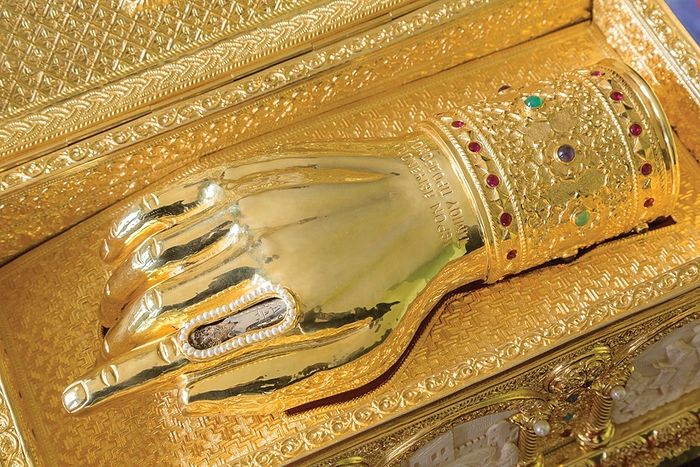 The finger of St. John the Forerunner
The finger of St. John the Forerunner
—Thank you very much for telling us about your wonderful monastery! If someone is interested in visiting the monastery, how can they go about making arrangements?
—We accept only men to stay overnight at our monastery and the easiest way is to email us at timiosprodromos@cytanet.com.cy if they are coming from abroad, and we can discuss the details with them.

